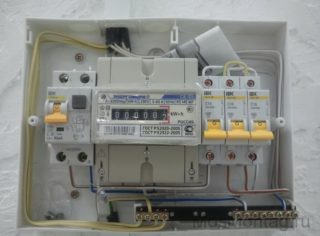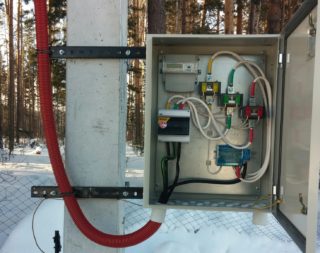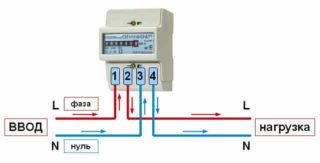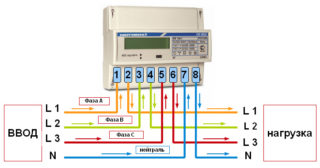Any consumer of electrical energy in its relationship with the supplier is guided by an agreement, which specifies in detail the rights and obligations of both parties. To avoid possible misunderstandings, a special recording device called a counter is installed at the entrance to the house. Installation of an electric meter in a residential building or in the country is a prerequisite for compliance with the clauses of the contract concluded between the supplier and the consumer. Before installing an electricity meter in an apartment, you need to thoroughly prepare for this procedure.
Organizational activities

The need to carry out work related to the installation of the meter, as a rule, arises in the following situations:
- in the event of a breakdown of the old device and the need to replace it with a new product;
- if you want to move the device from one place to another (from the corridor adjacent to the neighbors to the apartment or vice versa);
- when switching to a multi-tariff metering system in order to save energy.
Regardless of the reasons that gave rise to such work, each user should thoroughly prepare for them. First you need to write a statement to the supplying company with a request to install, replace or relocate the meter.
Situations are possible when Energosbyt officials demand to change the location of the device - to move it outside the apartment or house, for example. It is important to know that any requirements related to restrictions on its location within the boundaries of the premises violate the law, in which this condition is not specifically stipulated.
Further actions are reduced to making decisions on the following important points:
- selection of the type of meter that meets the requirements of the PUE and is suitable for specific operating conditions;
- when connecting to the mains for the first time after the approval of the application, technical specifications for the installation of a specific model of metering device should be obtained;
- if the new appliance is installed by yourself, you should be concerned about inviting a local electrician or company representative to confirm that it is connected correctly.
Fulfillment of the requirements for the organization of the upcoming work is the most important condition for the legality of the installation of the electric meter, regardless of who carried it out. In case of violation of at least one of the points of the requirements of the PUE - independent installation and connection of the electric meter will not be considered legitimate.
Installation Requirements

Before installing an electricity meter, you will need to decide on the following points:
- where is it better to install it: in the hallway, in the common corridor or on the street (the latter option is only suitable for a private house);
- how to choose a specific place in terms of height and distance from other communications;
- what shields, cabinets or niches are suitable for placing it.
Only after solving these issues, the installation of an electricity meter in an apartment can be carried out without breaking the rules.
Indoors or outdoors
Before installing an electric meter, you need to decide where it will be more convenient to take data on consumption from it and where it will be reliably protected from bad weather.This issue is especially critical for private houses that are not equipped with automated metering systems.
Under these conditions, it is customary to take the electricity meters out into the street, which allows the accountants to have access to them in the absence of the owners. Installing electricity meters in apartments has its own advantages and disadvantages. In an apartment building, in particular, it is more convenient for the owner to monitor the device if it is in the hallway. On the other hand, in this case, he bears full responsibility for his condition.
The line of demarcation of responsibility for accounting equipment (operational boundary) runs at the point of connection of the input power cable - up to the meter. In apartments that do not have an internal switchboard, the conditional line of responsibility runs at the location of the driveway niche with meters and automatic protection devices mounted in it.
Choosing a place and method of attachment

Compliance with the rules for installing electricity meters primarily comes down to choosing a place where it can be installed. In this case, they proceed from the following considerations:
- the device is best placed in the hallway at the front door, where it will be convenient for the accountant to take readings or monitor the status of the device;
- when placed outdoors, it is mounted on the wall, in common with the adjacent apartment in the corridor to the right or left of the front door;
- in the case of placing an electrical appliance on the street in a private building, the place for it is selected taking into account the convenience of taking readings, while it itself is thoroughly insulated.
The base on which the meter is mounted must be sufficiently strong and level. When choosing a method for fixing it, proceed from the characteristics of the place. In typical cabinets, it is mounted on a standard din rail, and on boards and in closed niches by means of dowels. The permissible deviation from the vertical is no more than 1 degree.
Installation height
This indicator is calculated based on the requirements of the PUE, which provide the following data for placement:
- installation at the level of the cabinet in which the meter is installed;
- in open places (in niches or on a shield), the place for the counter is marked at a distance of 0.8-1.7 meters from the floor;
- in rooms with low ceilings, it is allowed to choose this indicator below 0.8, but not less than 0.4 meters.
In each particular case, the choice of the meter installation height depends on the specific conditions at the place of its installation.
Overall dimensions of cabinets, niches, panels
In the provisions of the current norms and rules, the requirements for the size of niches and cabinets in which the meter is mounted are not specifically specified. The only case when the installation is considered incorrect is the absence of sufficient gaps in the width at the walls of the cabinet, allowing the connecting wires to be freely supplied.
The specific dimensions of cabinet structures, as well as niches and shields with a metering device, depend on the density of the placement of the entire set of protective devices, including automatic machines and RCDs.
Electricity meter connection

Upon completion of the installation of the device in the selected place, you should figure out how to connect the electric meter to the current network. The sequence of operations carried out before connecting it:
- First, you need to de-energize the home power grid by turning off the voltage with an input circuit breaker.
- Then you will have to remove the cover on the meter panel, first removing the seal.
- Directly below it is a line of connection terminals with a set of conductors.
- It is advisable to take a photo of the entire terminal block, fixing the order of their connection.
- Then you can disconnect them and release the electricity meter from the fasteners so that you can install it in a new place.
If the conductors are not marked by the color of the insulation, they must be labeled with numbers corresponding to the contact number on the block.
All subsequent actions are related to the direct connection of the device to the mains.They are performed in this order:
- At the selected location, a cabinet or shield is mounted, which is then securely fixed to the wall.
- A harness is connected with the marked veins of the old wiring or with a new wiring diagram if the device is installed for the first time.
- You can start connecting the pre-marked conductors to the numbered terminals on the meter.
- Care must be taken to ensure that the screw fasteners are tightened to the stop.
- Upon completion of these operations, a representative of Energosbyt should be invited, who will register the installed device and seal it.
In the passport of the electric meter, a note is made about the installation time, and the indications officially registered at the time of its commissioning are also recorded. Only after that, it can be considered that all work is completed, the installation of the electricity meter was carried out legally.
Some nuances of installation

Before installing an electric meter in a pre-selected place, it is important to consider the following nuances.
- in the case of servicing 380 Volt power networks, you will need to purchase a three-phase device;
- if you want to install two meters at once, you will need to obtain permission from Energosbyt - usually this method of calculating for electricity is not approved by representatives of the supplying organizations;
- a similar permit will have to be obtained if there is a desire to put an additional meter in a communal apartment to light;
- in dilapidated houses or other similar buildings, it is allowed to mount it only after a solid foundation has been prepared.
If these requirements are not met, no supplier representative will register the device. The same consequences await the user if, when connecting it independently, the order of commutation of the lead wires was violated.
The installation of electricity metering devices in a private house or apartment is a rather responsible business that needs serious documentary confirmation. This means such mandatory procedures as registration and sealing of the meter, as well as entering the initial data into the passport.








